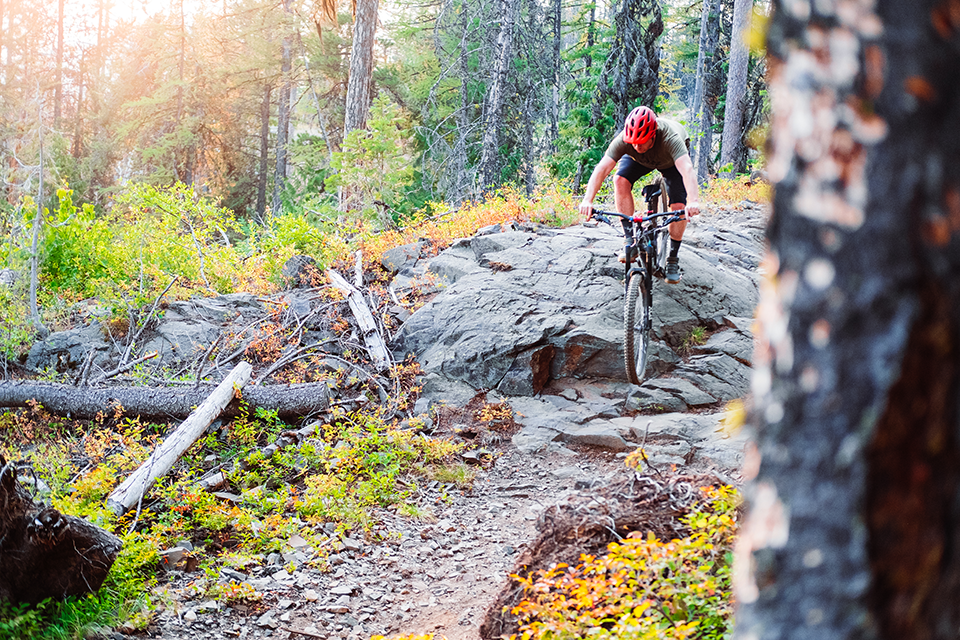As one of the birthplaces of freeride mountain biking, the Kootenays of southeast British Columbia have accumulated decades of world-class trails on seemingly any slope that can hold them. But trail builders here continue to find new zones and touch up classic Kootenays tracks. The riding riches in the old mining-turned-mountain towns of this region—Nelson, Rossland, Revelstoke and elsewhere—are nowhere close to being played out. Border-crossing bikers who have missed a few seasons of BC brown pow will find that a few more trail treasures have been unearthed in their absence.

Kaslo’s Mount Buchanan Trails
A little less than an hour north of Nelson, on the northern arm of Kootenay Lake, the sedate lakeside town of Kaslo has long functioned as an extension of Nelson’s riding scene. The historic highlight of the area was The Monster, an iconic 4,000-foot descent off the flank of Mount Buchanan on the northwest edge of town. But with a long, rough shuttle and steep, high-consequence pitch, The Monster scared away all but the most committed riders. Several years ago, however, the Kaslo Outdoor Recreation and Trails Society began a multi-year project to build out the Buchanan trail network.
On the west side of Mount Buchanan, the Kaslo Interpretive Forest Recreation Area features a network of mostly machine-built flow trails. Debuting in 2022, Friendly Giant is the first segment of what will ultimately be a 22-km bi-directional trail to the summit of Mount Buchanan. The mellow bench-cut trail makes for a pleasant pedal up, and the numerous grade reversals, small tabletops, and side hits make for a manageable alternative to The Monster for the ride back down.
On the east side of Mount Buchanan, the Branch 7 trail system comprises a handful of hand-cut singletrack. The highlight is the steep, surfy singletrack and root drops of Carlsbad; combining it with the fall-line flow of No Brakes gives riders a nearly 2,000-foot descent back to Kaslo, where they can cool their brake rotors at any of three ice cream shops.
Combined with the XC-oriented trails of the True Blue Recreation Area trails on the south shore of the Kaslo River, the new Mount Buchanan trails elevate Kaslo to a riding destination that holds its own with its Kootenay kin.

Nakusp’s Mount Abriel Trails
In contrast to its neighbors’ trail systems, which grew by accretion, the trails of Nakusp, on a narrow ribbon of Upper Arrow Lake an hour south of Revelstoke, seemingly sprung from the Earth fully formed and optimized for modern bikes and rider preferences.
Several years ago, with the aid of around a million dollars in community grants, the Nakusp and Area Bike Society (NABS) began quietly building out a 50-kilometre trail system on the steep, cedar-shaded flank of Mount Abriel—the largest community-based trail project in Canada. The goal for this quiet, lakeside community: join the likes of Nelson and Rossland in the canon of Kootenays riding destinations.
The mix of loam and crushed bedrock on cutover Crown land allowed for the construction of bike-park-like flow trails such as Dusty Panther, one of those tracks that transcends its difficulty rating to delight riders of every skill level. Trails like Black and Blue and Minty Fresh artfully blend in big hips and gaps with steep, chunky singletrack that maximizes the 3,400 feet of vertical from the top of Mount Abriel to the highway.
Below the highway, NABS constructed a skills park with pump track, drop and jump lines, and a shoreline campground with 30 well-spaced, private sites. A mini network of lower trails allows for after-dinner hot laps on beginner to expert trails, and trails like Hollywood Hills (double black) and Red Shed Redemption (black) are nearly worth the trip alone.
At a time when “something for everyone” is the builder’s buzz-phrase, the NABS means it: Mount Abriel is one of the world’s first networks of trails for adaptive bike use. It’s also one of the birthplaces of trail standards for adaptive mountain bike trails, which seek to codify tracks optimized for hand-, pedal- and motor-powered three- and four-wheeled bikes. Thirty years on, the Kootenays continue to extend the borders of what’s possible on a bike. There’s no better time to cross that border.













